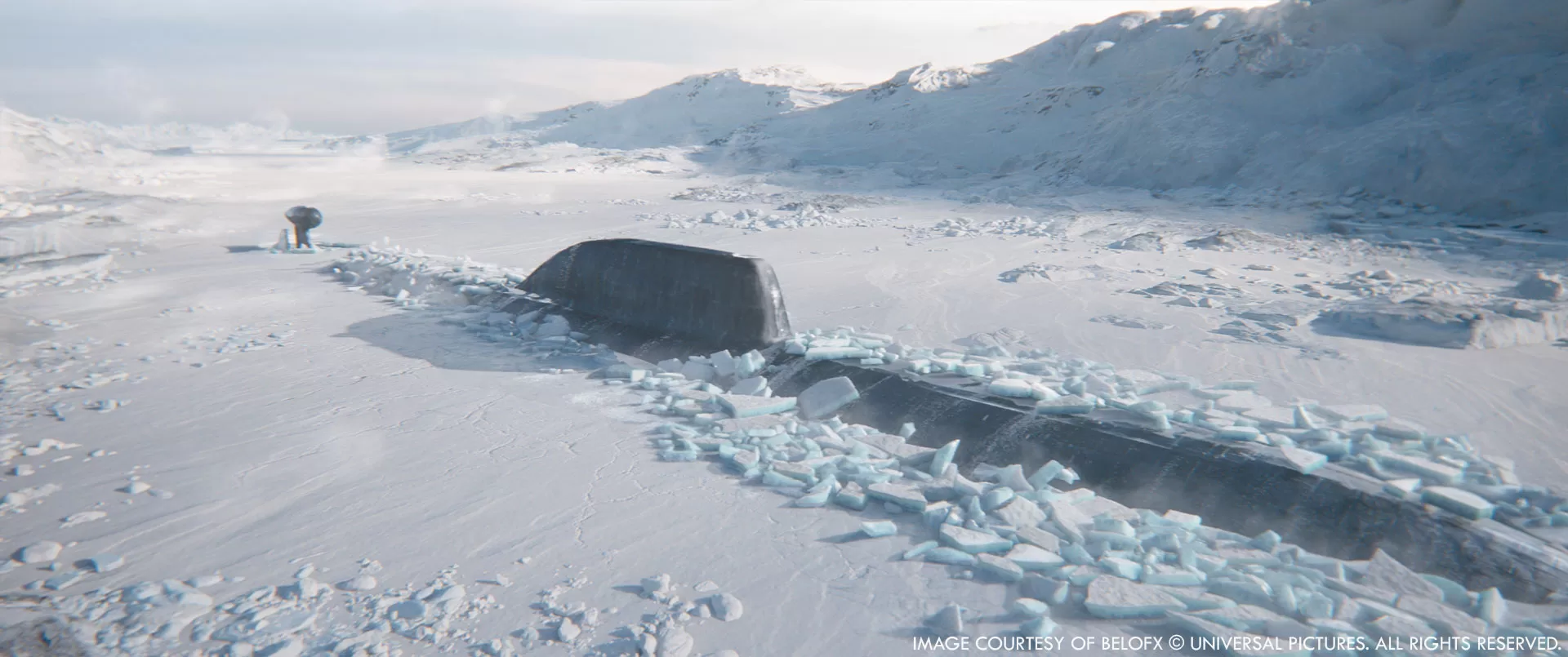Back in 2022, Huw Evans talked to us about the work of DNEG on The Matrix Resurrections. He then joined the beloFX teams.
How did you and beloFX get involved on this show?
On paper, it might have seemed strange that our new, barely one-year-old company (at the time) was entrusted with roughly 400 shots on the latest instalment of such an iconic series. But we’ve individually worked on and off with Peter Chiang for many years. He recognises the calibre of artists we have here at beloFX, so there was never a question of whether we could handle it or not. That said, it was the largest show we’ve done at belo so far!
What was your feeling about entering this iconic franchise?
I’ve been a big fan of the series since the beginning. I’m not a petrol-head at all, and don’t have a huge interest in sports cars as such, but the movies are just so much fun to watch and experience. As soon as we heard about this project coming up, we were all very excited to be involved. The last Fast and Furious movie I worked on was back in 2009, on the fourth film — aptly titled Fast and Furious! I think we’ve all probably worked on one or more of these movies along the way, and each time there’s always some great VFX challenges as the action and scope of storytelling increases, and that certainly keeps it interesting!
How was the collaboration with Director Louis Leterrier and VFX Supervisor Peter Chiang?
As mentioned above, I’ve worked with Peter for a number of years across various projects — actually going back about 16 years or so, our first time working together was on a film called Stardust (a very fun movie, I recommend seeing it!). He’s always such a pleasure to collaborate with and that’s really what it is, a collaboration. Peter is great at letting us explore new ideas and encourages everyone to bring new thoughts to the table, which is always rewarding. He also has a really keen artistic eye which I massively respect. It was great having him and Louis working so closely together. We were always able to get timely feedback on our work which helped ensure that we were keeping up with what the director needed as he needed it. We had to be a well-oiled machine on this project, and that access to Peter and Louis was invaluable.
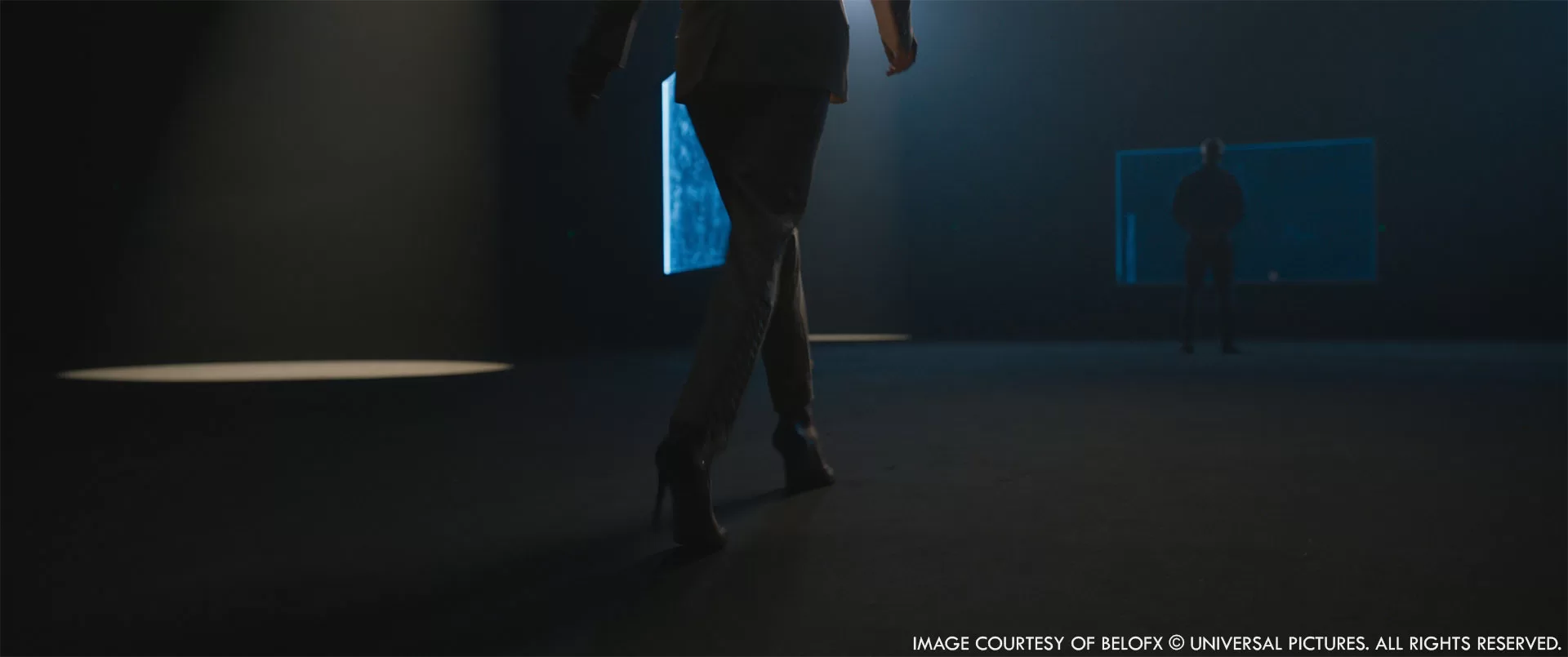
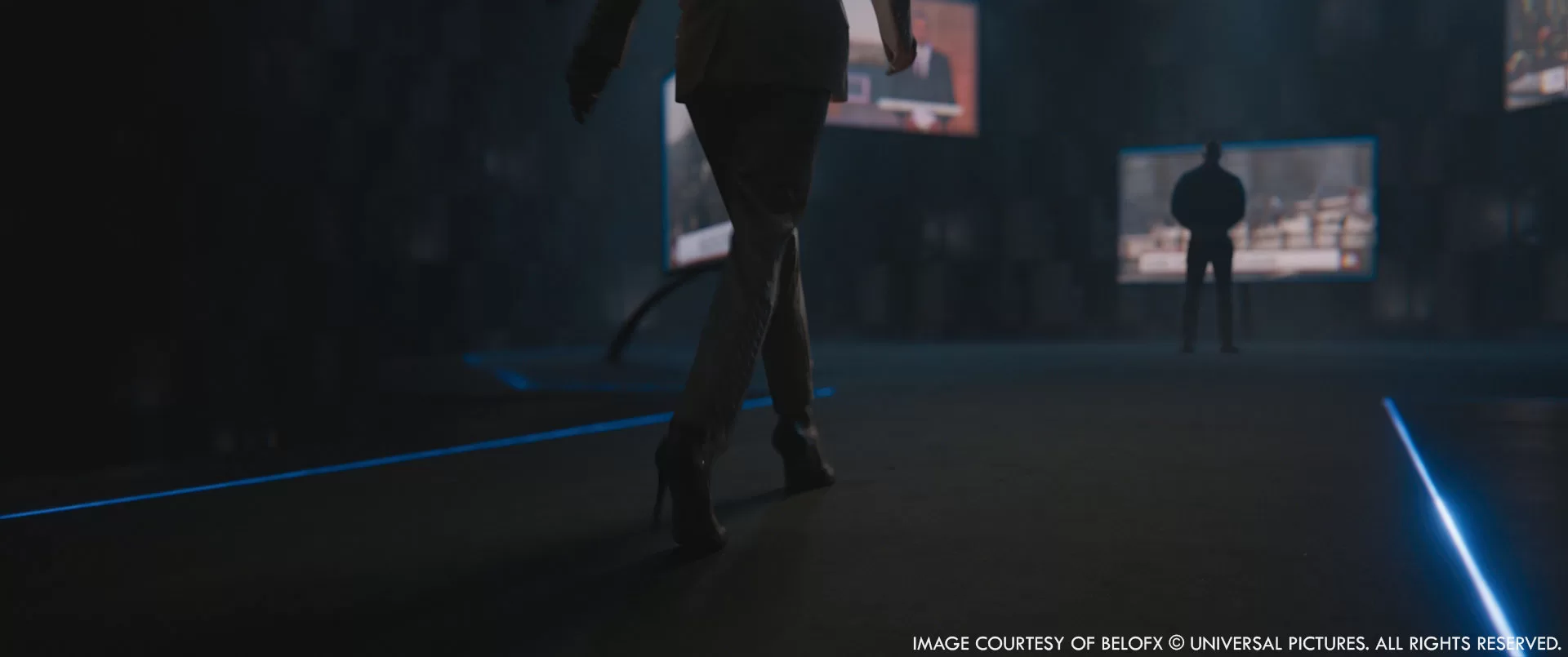
How did you split the work amongst your and the beloFX offices?
The production hub was based with our London team but we had work running globally across our Vancouver, Montreal and India sites too.
What are the sequences made by beloFX?
We were involved in various sequences including Agent Aimes’ high-tech, minimalist briefing room and the lift shaft fight sequence that occurs as Cipher is escaping from her high-rise building. We also had a few sequences inside and outside the Toretto house – including the attack on Mia and Lil ‘B indoors and the family BBQ that happens outside. Then there was the big fight that happens between Letty and Cipher in the medical lab as well as Jakob and Lil’ B’s escape in their canoe-turned-plane. Finally, we also worked on the endless icy environment where Letty and Cipher are greeted by a cresting submarine breaking through the ice.
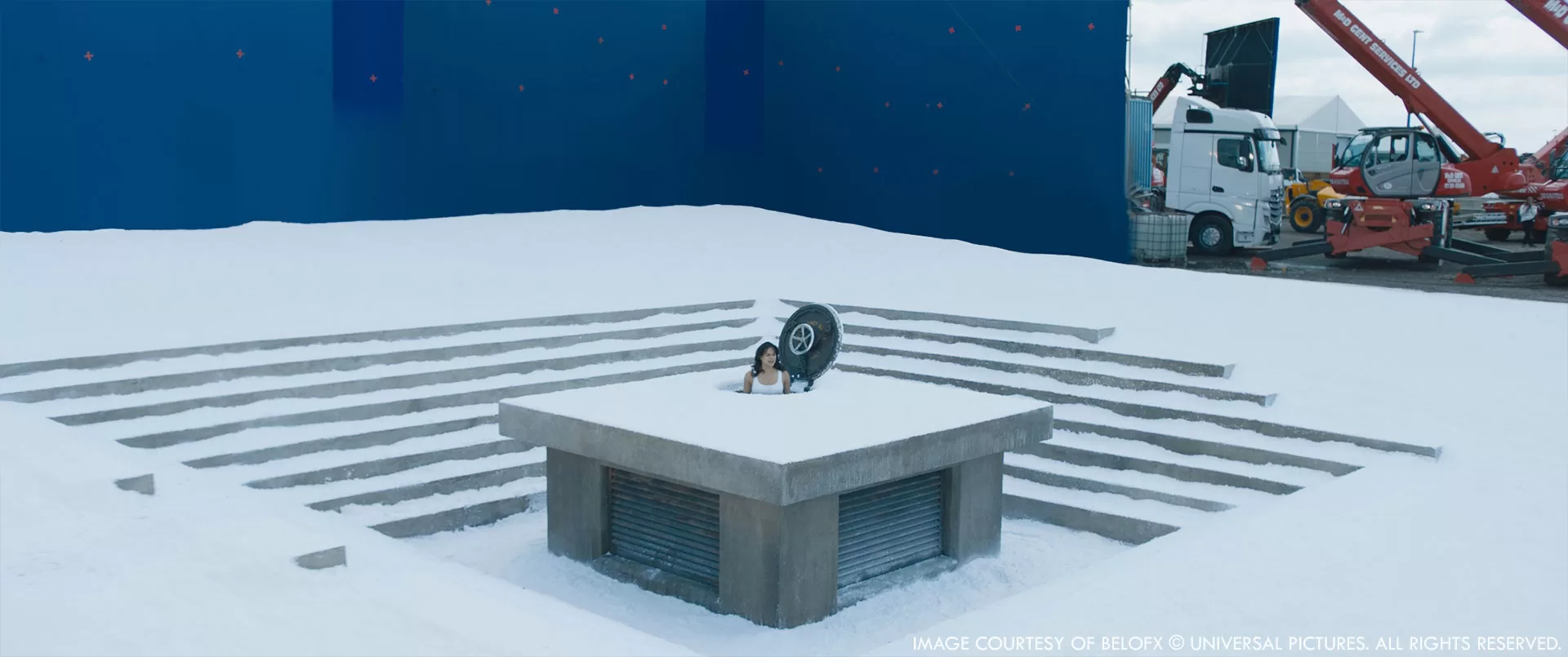
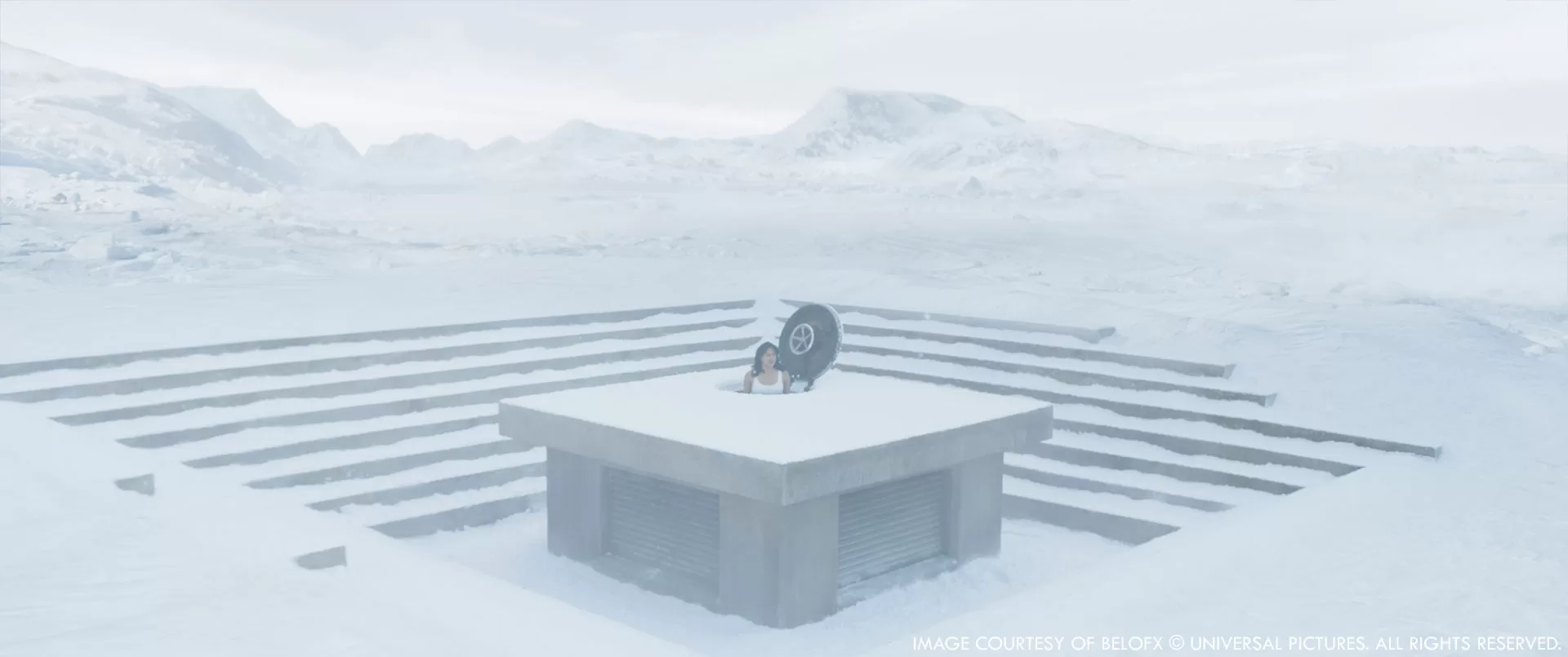
Can you elaborate about the design and the creation of the medical robot?
The medical robot was designed practically, and was used as-is in wider shots where we don’t see it moving. But for the close-ups and animated shots, we built a digital version based on lidar scans and photography of the practical model. We then augmented it with some new tools and details to create a bit more movement and interest in the shots. We had some freedom in terms of which bits would move, so our animator Alex Melville came up with a couple rough ideas which we communicated back to the build and rigging teams to update accordingly. Of course, we had to throw a little HAL reference in there too.
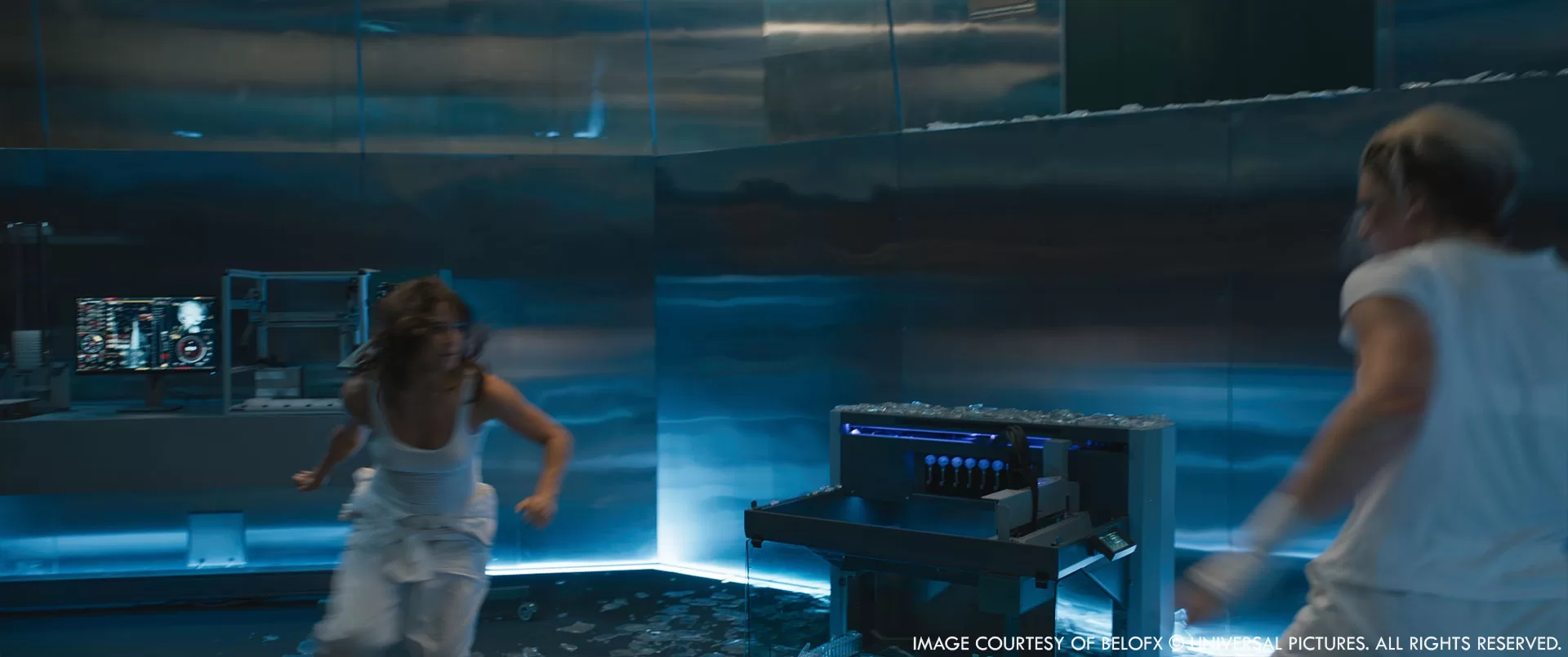
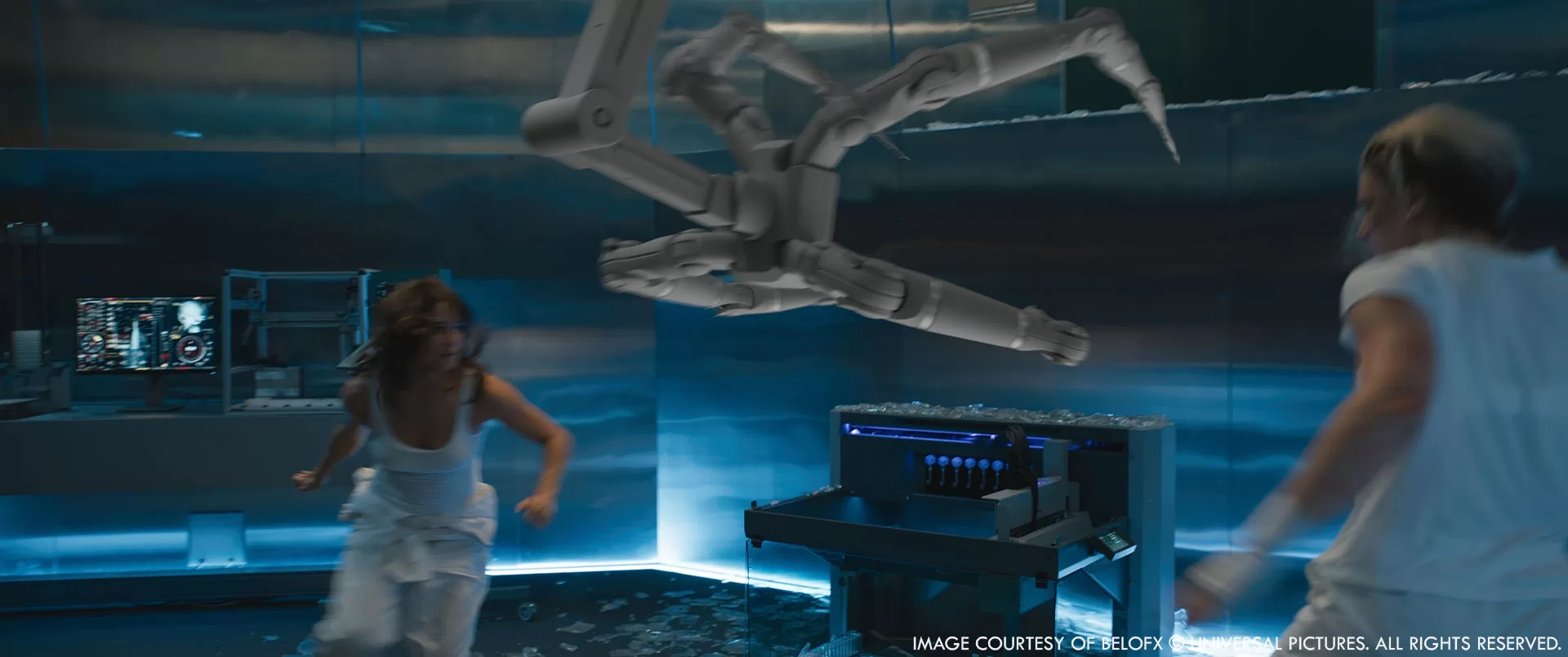
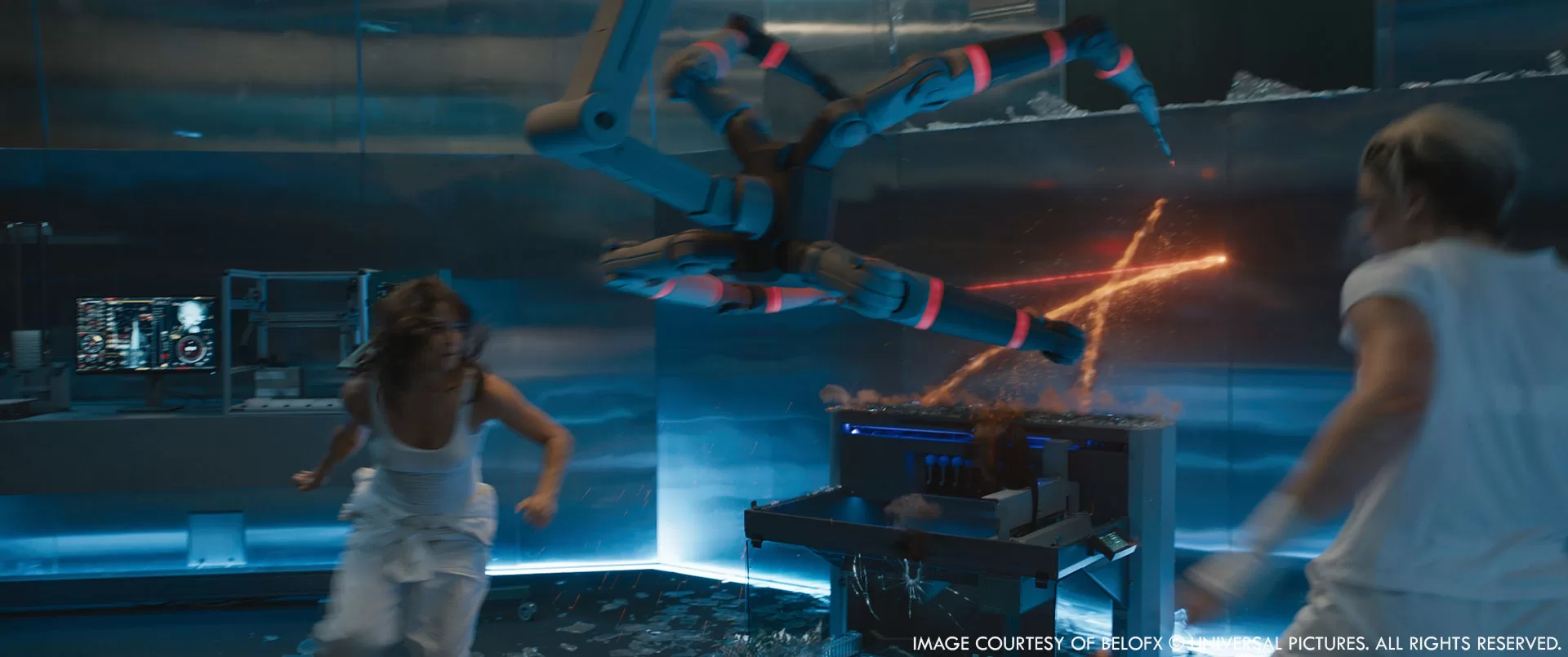
How did you create the digital doubles?
The digi double work on our particular sequences didn’t warrant a full digi build, so instead we used a combination of techniques. There was a mixture of some machine learning tools, some projection-based approaches and even some more simplistic 2D tracking of elements taken from surrounding shots to get the results we needed
Can you elaborate about the creation of the icy environment?
The icy environment was created and rendered in Unreal Engine by one of our talented Generalist Artists Deanna Crisbacher. At belo we utilise the strengths of Unreal in our pipeline wherever possible, and this was the perfect opportunity to do so. We were able to block in mountain shapes at speed and easily jump around camera angles, so we had great control in finding a composition that worked across all shots. This also helped us respond to client notes quickly and roll out those changes across the whole sequence. Once we had the base environment, we generated a library of FX simulations (snow dust being blown around, snowy particulate blowing through the air) which we mixed and matched, depending on the shot, to give us that nice Arctic feel that Peter and Louis wanted. Then it was down to our amazing comp team, for this sequence helmed by Andreas Andersson, to bring it all together and dress in some selective practical elements to give us that final look.
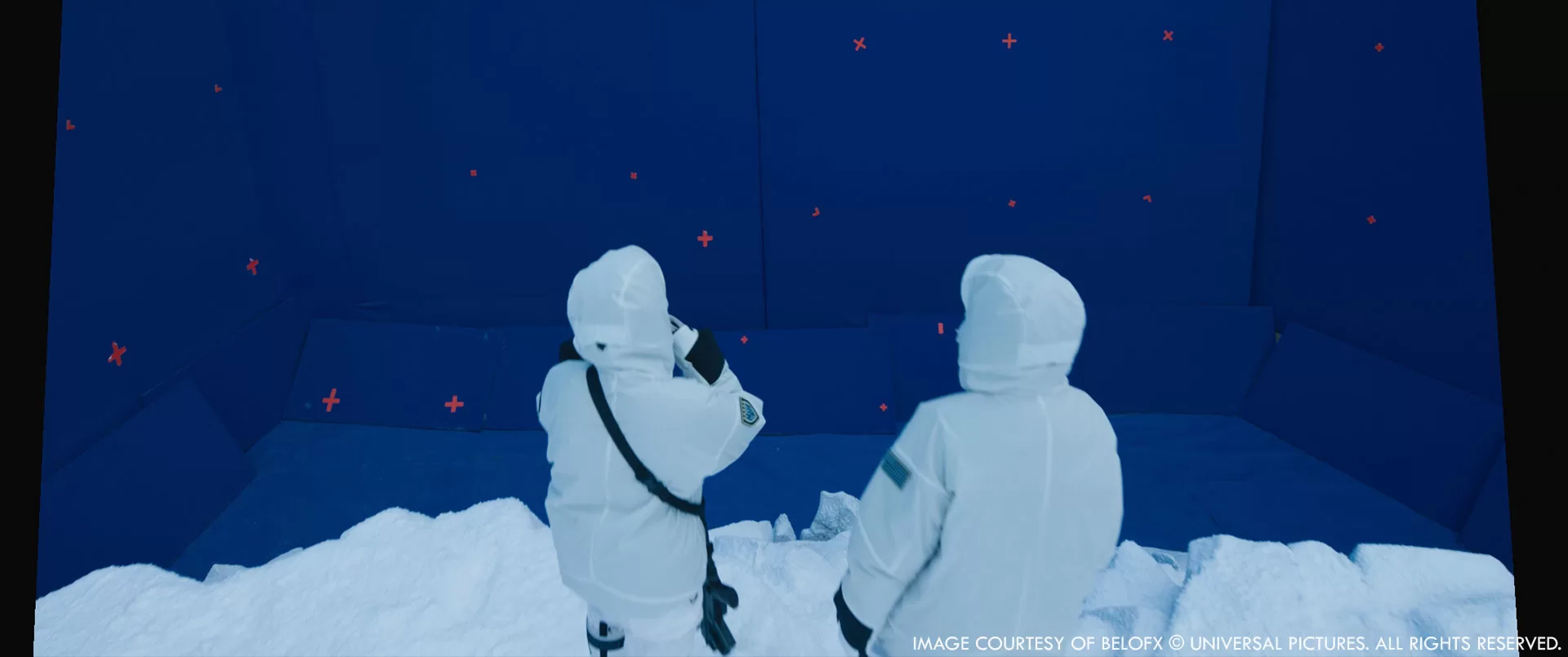
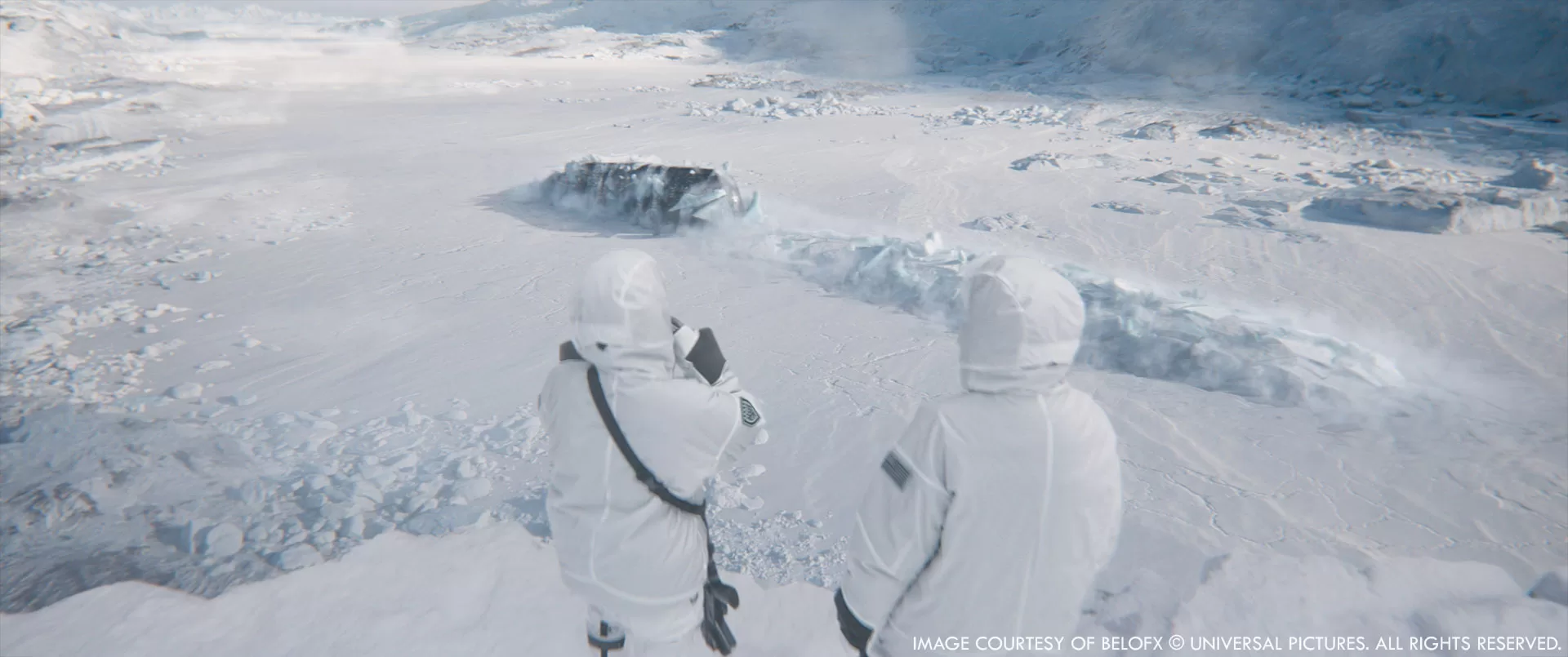
How does the strong sunlight affect your work?
Lighting for this sequence was a bit of a juggling act. We had to balance a stronger sunlit directional look for the wide shots — particularly where the submarine was cresting through — and balance that with some close-up plate photography that was shot under more overcast conditions. We’re used to these types of challenges, and it’s all about finding smart solutions to bridge that gap, whether it be relighting the plate photography a certain amount before it breaks, or introducing some dappled cloud cover to help in select areas. Tricks like that will always help us get to where we need to be. One big focus with the stark sunlight was ensuring there was enough detail in an otherwise featureless environment. It was important to pick up interesting shadows or specular kicks on the snow so that it didn’t read as an unrealistically plain, very-CG-feeling environment.
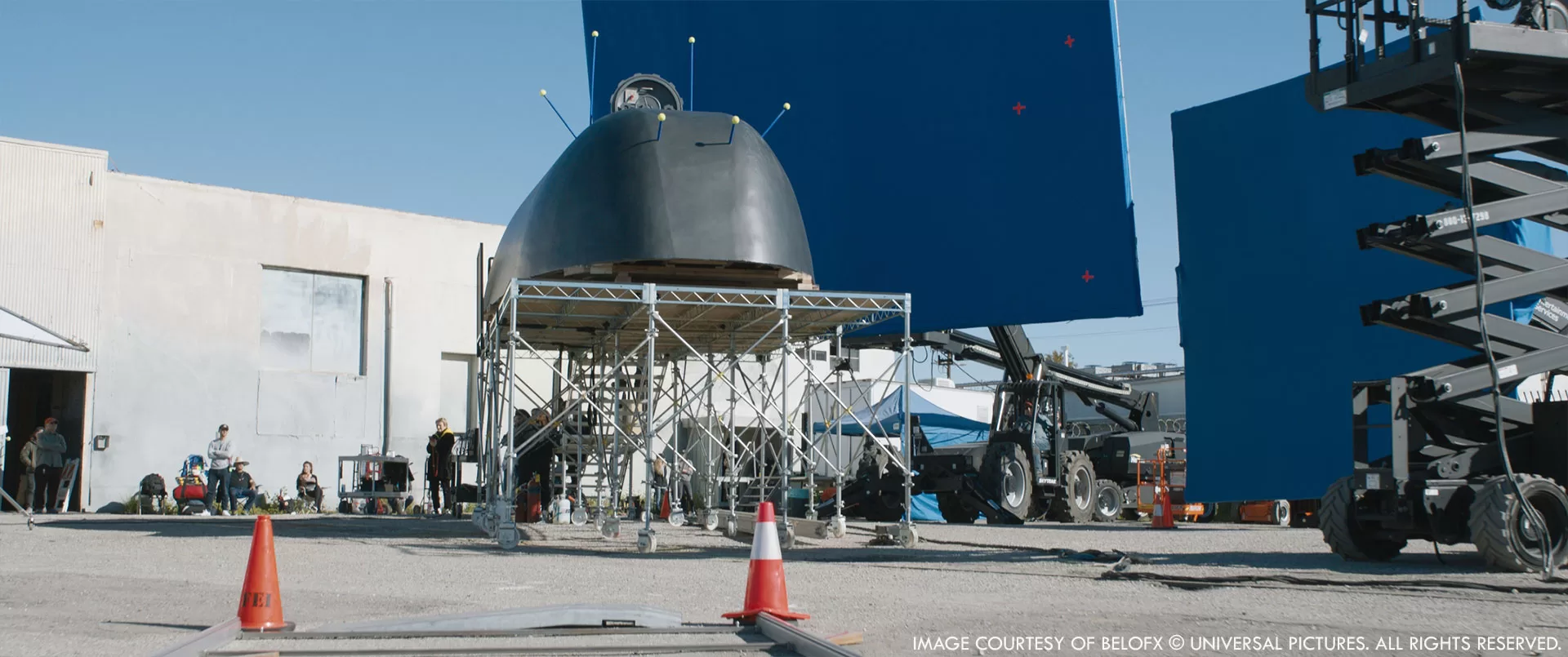
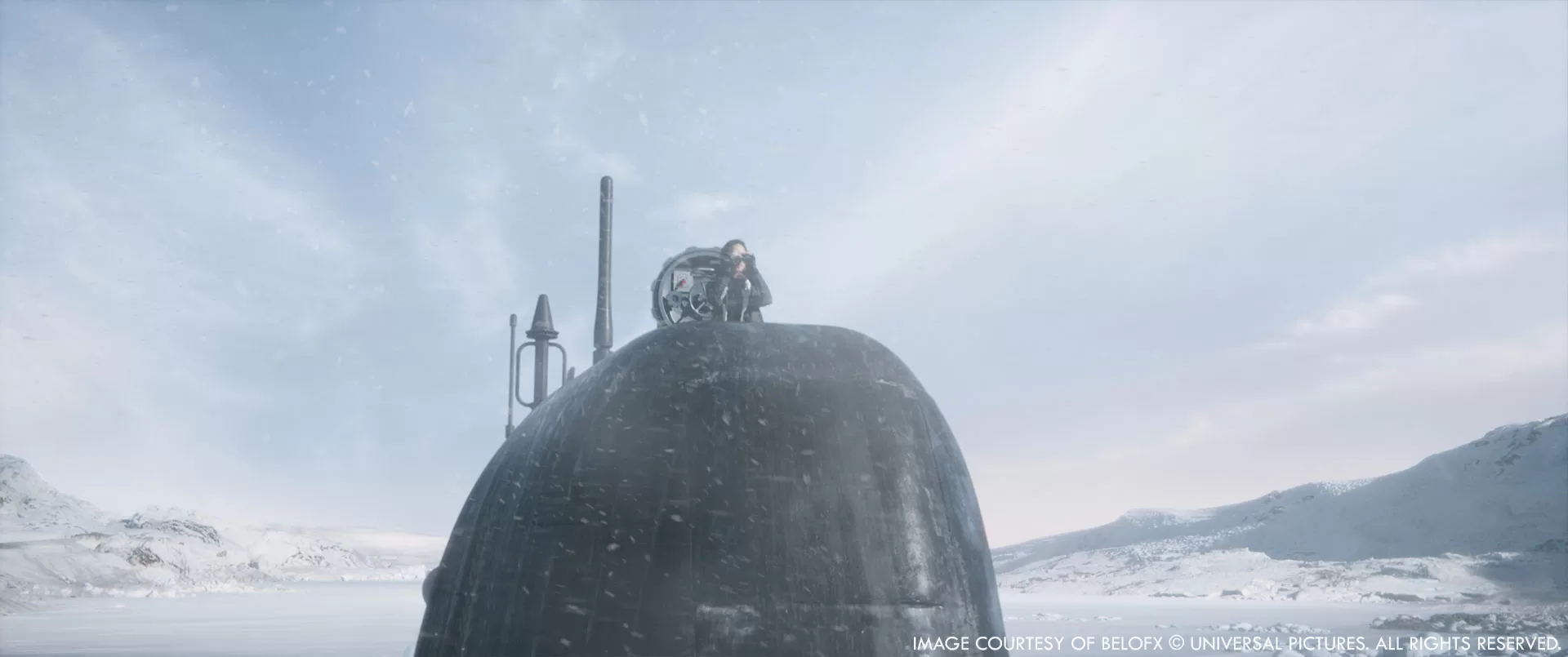
How did you create the submarine?
The submarine was based on an Akula-class nuclear-powered attack submarine, but with some modifications based on some artistic license. We also wanted to ensure it matched with a partial set piece for interaction with Gal Gadot’s character, Gisele. It was predominantly modelled in Maya by Narissa Wall and Sandesh Chonkar under the supervision of Phil Bonner, our Build Supervisor.
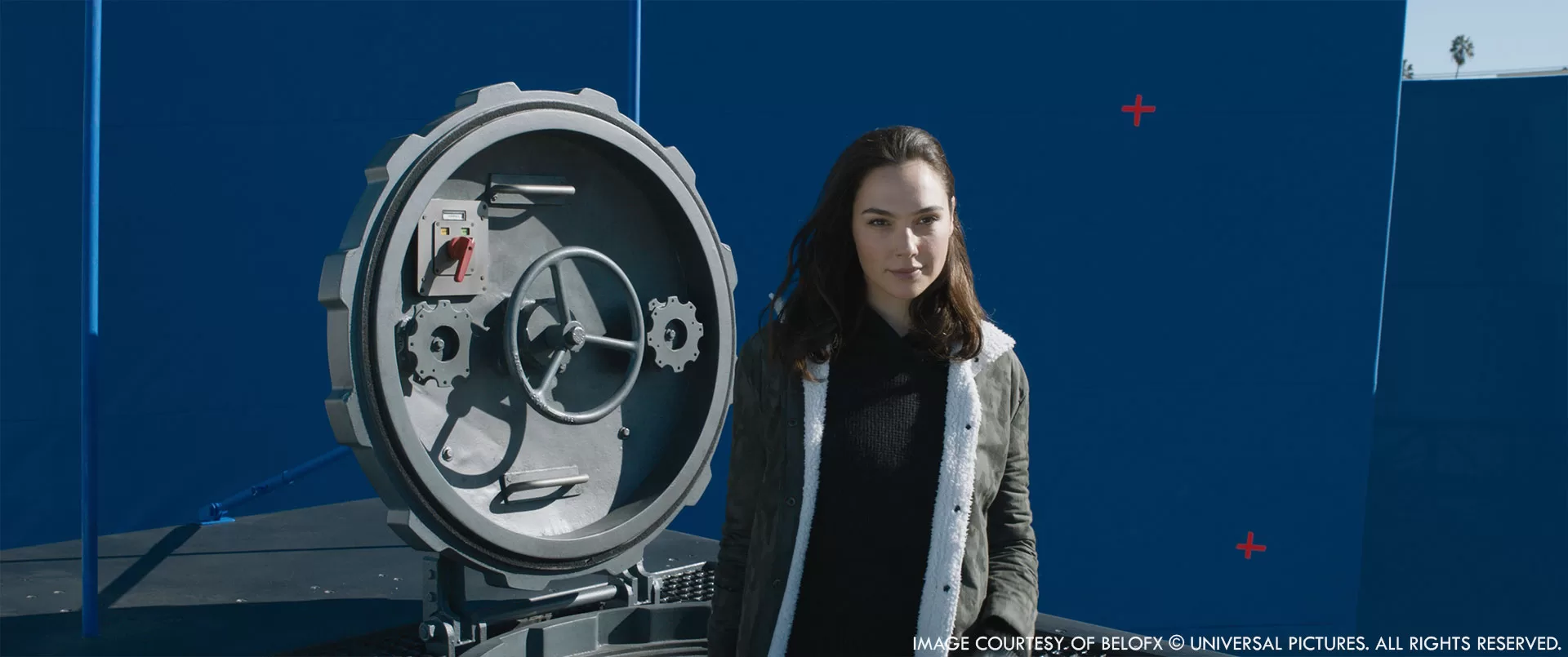
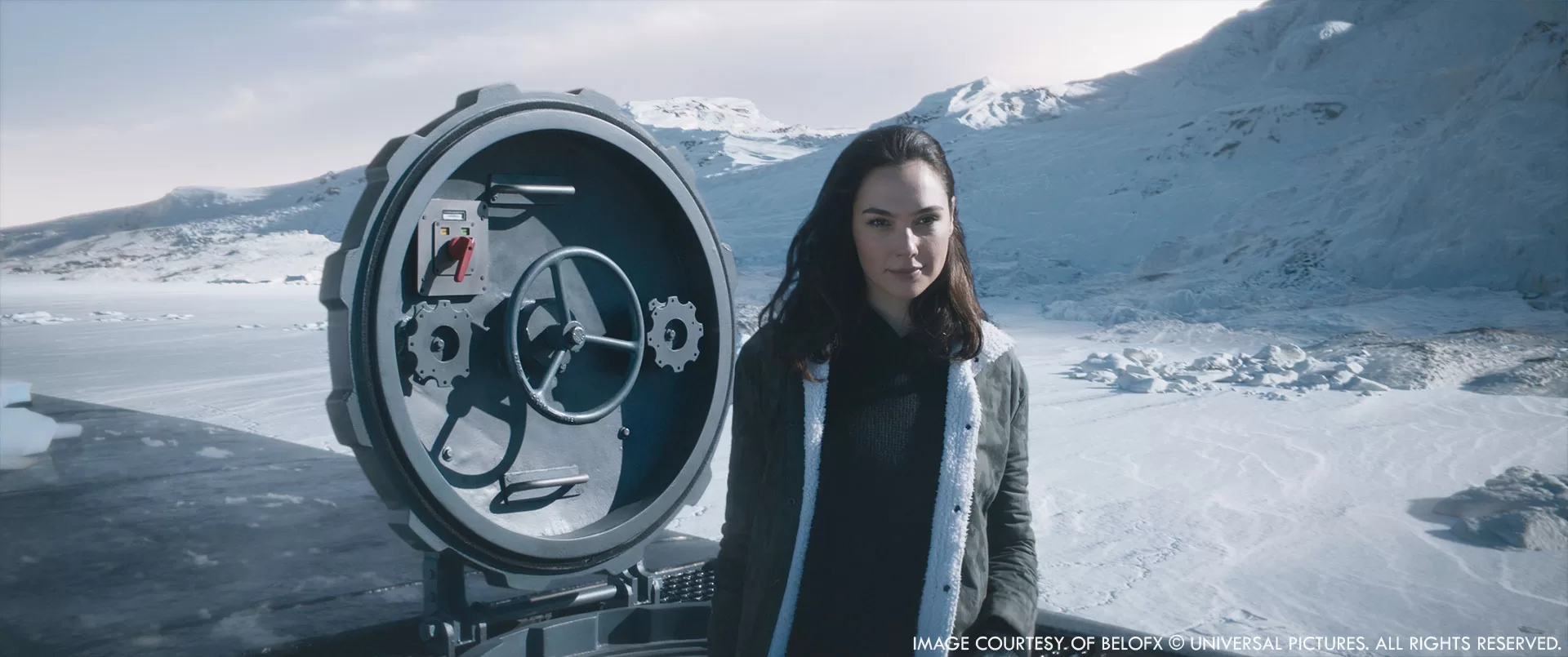
What were the main challenges when it cracks the ice?
The FX simulation work, similar to the creation of the icy environment, required a set-up that worked across multiple camera angles, that kept simulation time to a minimum, and that also kept consistency between shots. We ran the animation and simulation as an overlength piece covering the whole action beat, and this gave us a really solid base that we could work from for any additional shot-specific tweaks.
The main challenge here was finding the sweet spot between reality and “movie-reality”. Looking at real world references, submarines poke through the ice fairly calmly, with some gentle breaking of ice chunks which still looked cool, but didn’t have that slightly more explosive edge we’ve come to love from the Fast and Furious series. So we had to amp it up a bit. Once the main simulation work was complete we had to add the smaller details in, such as additional water drops and cascades and additional falling snow dust, things that help convey scale and stop the shots from feeling like a miniature. This was done with a mixture of simulated elements and practical elements.
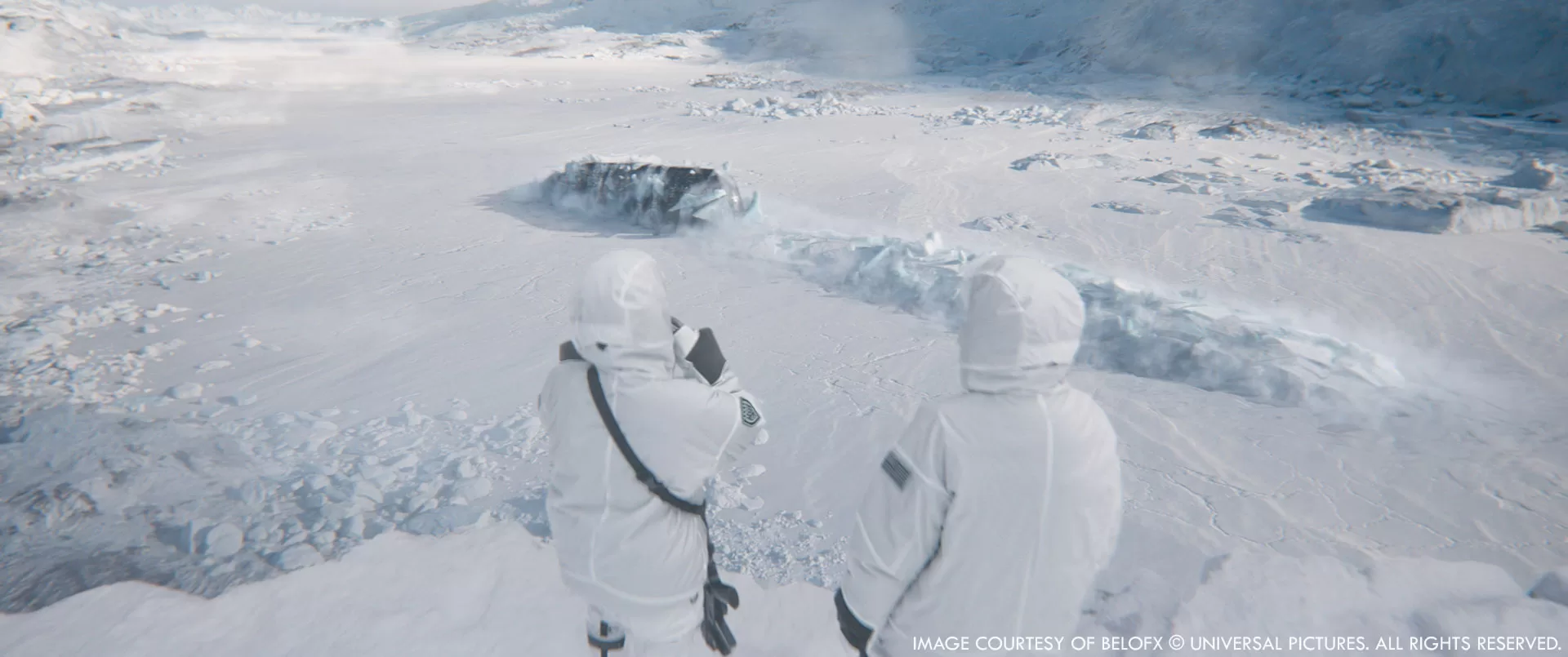
How did you create the plane and especially the small one?
The C-17 plane was modelled by Sandesh Chonkar, while the mini canoe / glider plane started from the practical model that was created on-set which was then scanned and photographed. We had to add the glass domes and figure out how the wings would work and behave as they unfurl. Our animator Alex Melville did a great job blocking all this out and ensuring we had an open dialogue with Peter to nail down the idea before we worked on all the final details of the build and the rig.
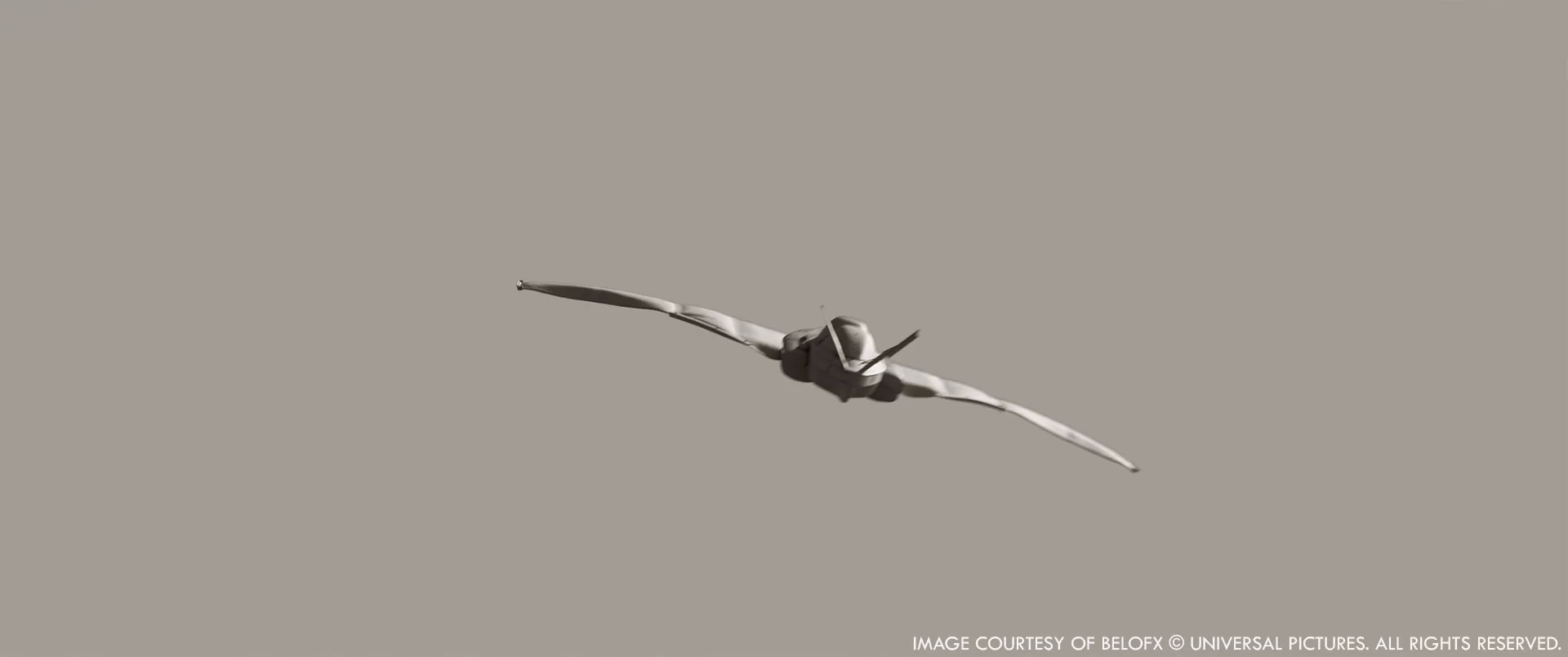
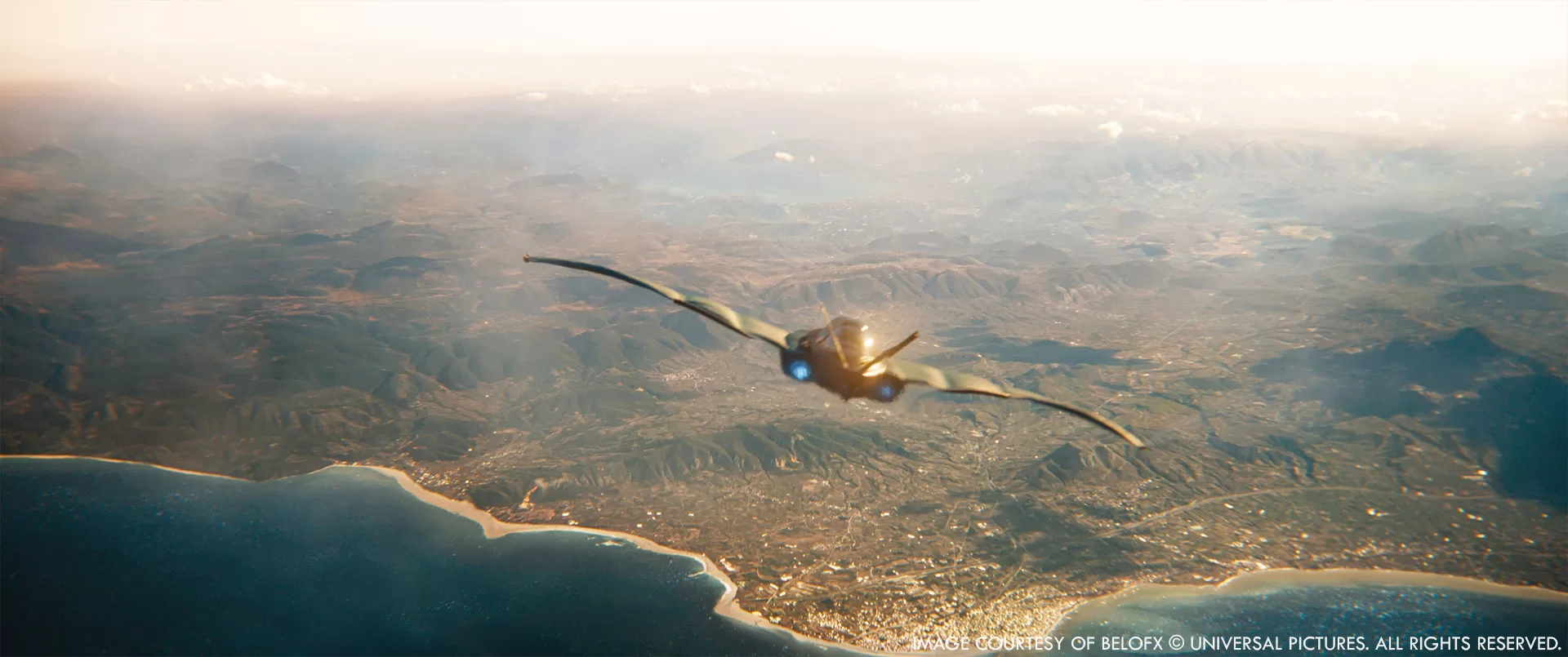
Can you elaborate about the Los Angeles environment work?
We had a few sequences set in or around the Toretto family home, and this required different levels of background top ups or digital set extensions. These sequences generally had quite a high shot count and so with the various views of different sections of environment around the house, we decided to use Unreal Engine in crafting and ultimately rendering these shots. In addition to making blocking for the sequence more manageable, this also made it more straightforward when rolling out new renders across a hundred or so shots as we didn’t require an army of artists. Our Unreal renders would then go straight into Comp for the finishing touches.
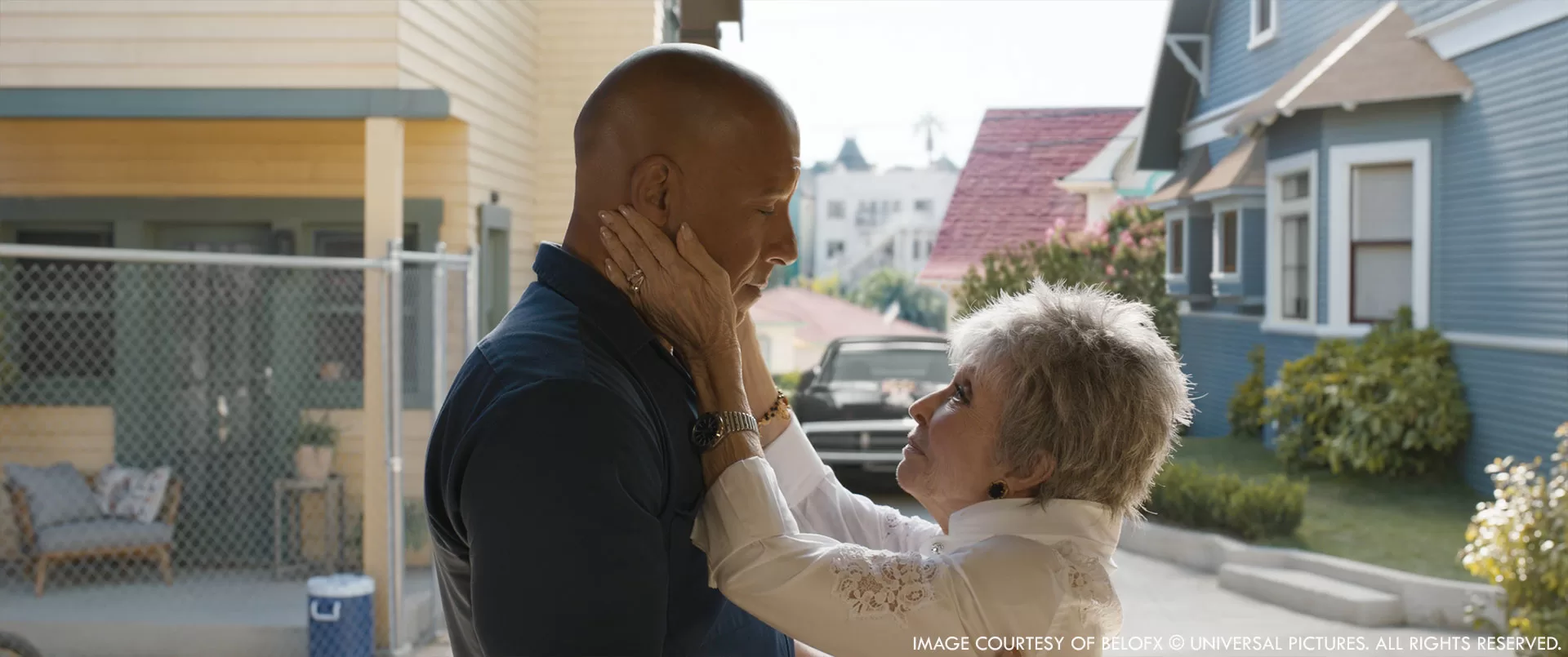
Which shot or sequence was the most challenging?
This is a bit of a cop-out answer, but I feel we had different challenges across each sequence!
For Agent Aimes’ briefing room, we had to turn what was essentially an empty warehouse into an interesting, techy-yet-minimalist space. Then for the fight sequence that occurred in the lift shaft, we needed to get just the right levels of increasing damage and sparks, while keeping the storytelling visible and not too obscured. During the Toretto house shots, the challenge was just covering the sheer quantity of work across those sequences while ensuring the quality level remains high.
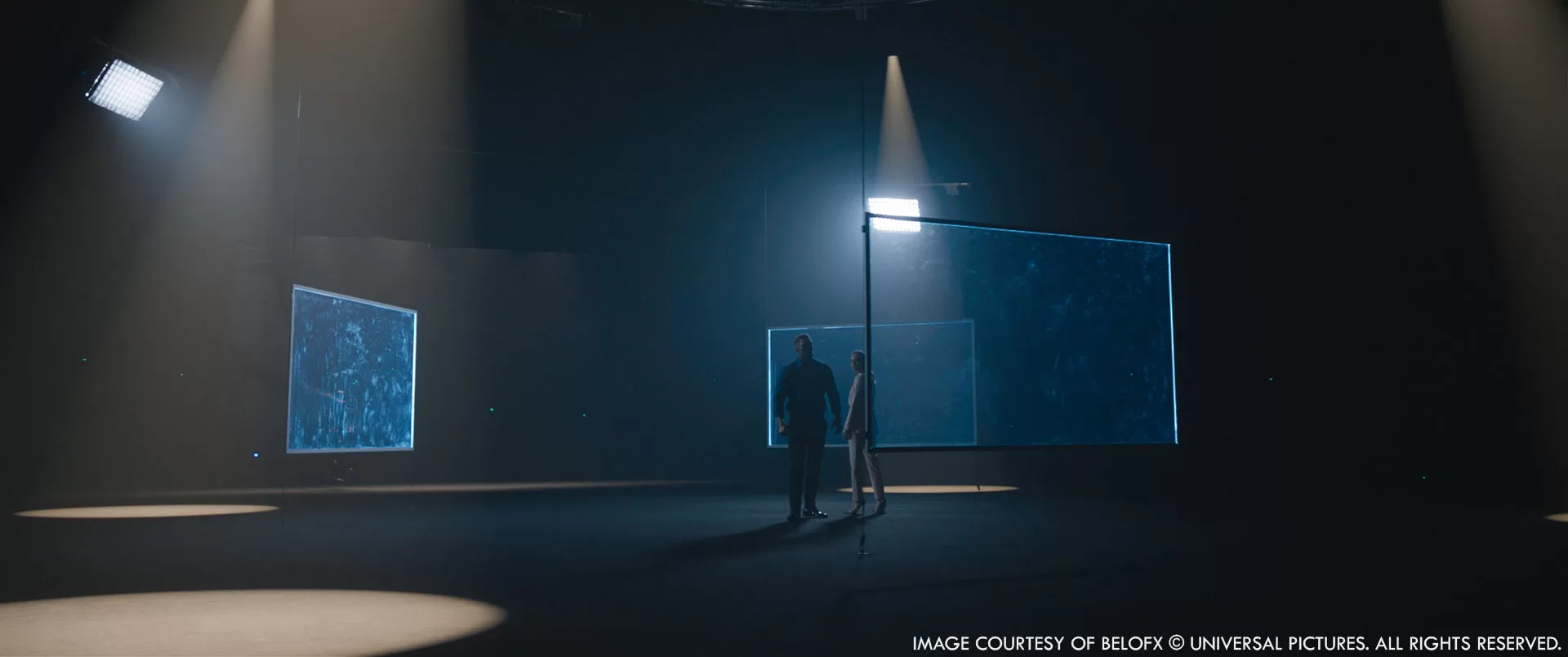
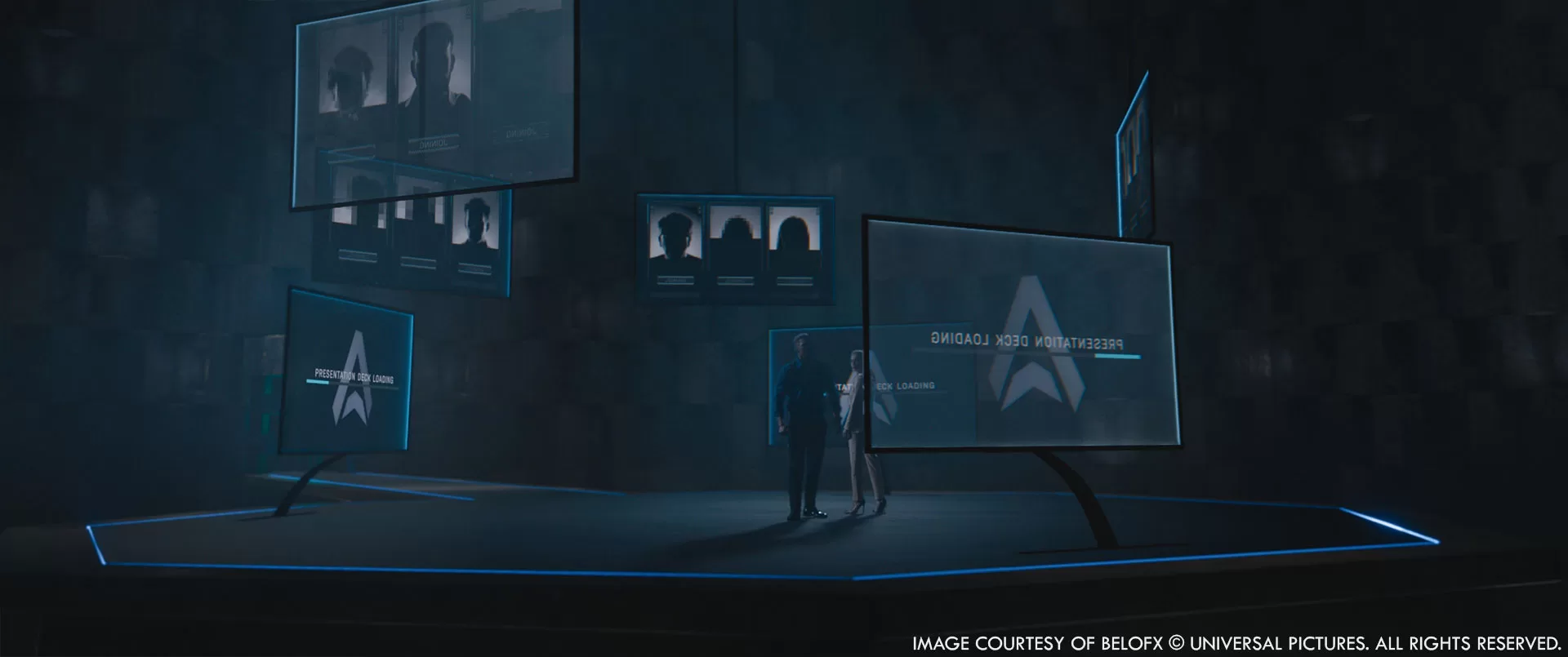
We also had a high shot count during the Medical Lab fight sequence, and some of the trickier work here revolved around removing stunt/support brackets amongst the glass panels that surround the room. Dealing with reflections and transparencies with lots of moving parts is always a fun challenge, but we had some incredible work from both the prep team and our environment artist Caroline Sandgren, who did some excellent environment patches. Not to mention the tricky stunt actor cleanup while lights are flickering on and off, casting various shadows everywhere. Our Comp Supervisor covering this sequence, Gabriel Curpas did an awesome job with some rather painful work there! So yeah, plenty of challenges really! Oh and of course the submarine coming through the ice… That’s probably the biggest one thinking about it.
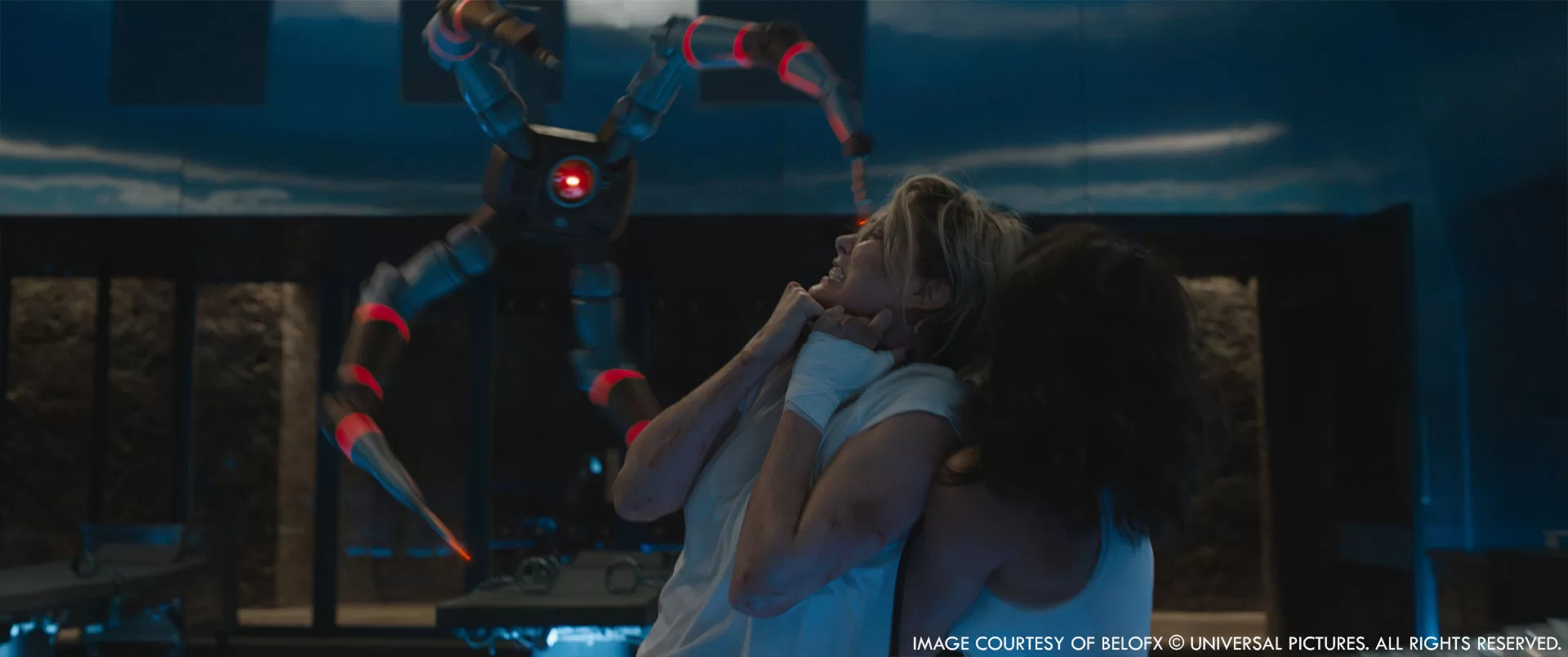
Is there something specific that gives you some really short nights?
I don’t think there was anything specific, just the whole thing really! Maybe the submarine breaking through the ice… those were always going to be the shots that go right up until the end! But we certainly had some really short nights — well, short if you count the amount of time sleeping, but long if you count the amount of time working!
What is your favorite shot or sequence?
All of them! Ha! There’s a few shots in the Medical Lab fight, where Letty and Cipher smash through a window and land on a glass cabinet, which then shatters to pieces. On-set the actors landed on and interacted with a large blue bean bag, so the work involved in transforming that into a solid, smashing glass cabinet — while repairing bits of the character interactions — was probably my favourite. Also as someone who has a son who loves wrestling and in particular John Cena, I think getting to work on the shots where he uses his ‘Attitude Adjustment’ finisher and slams the goon through the floor was pretty cool!
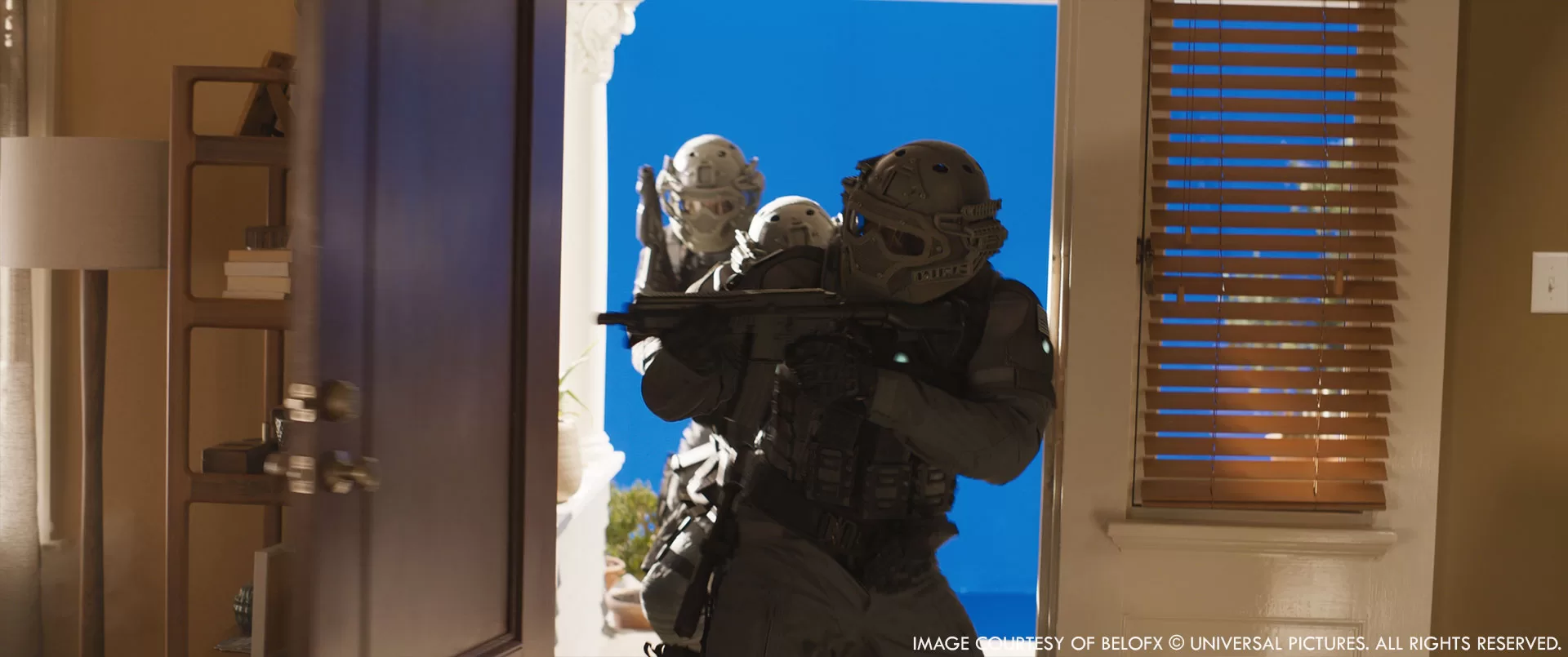
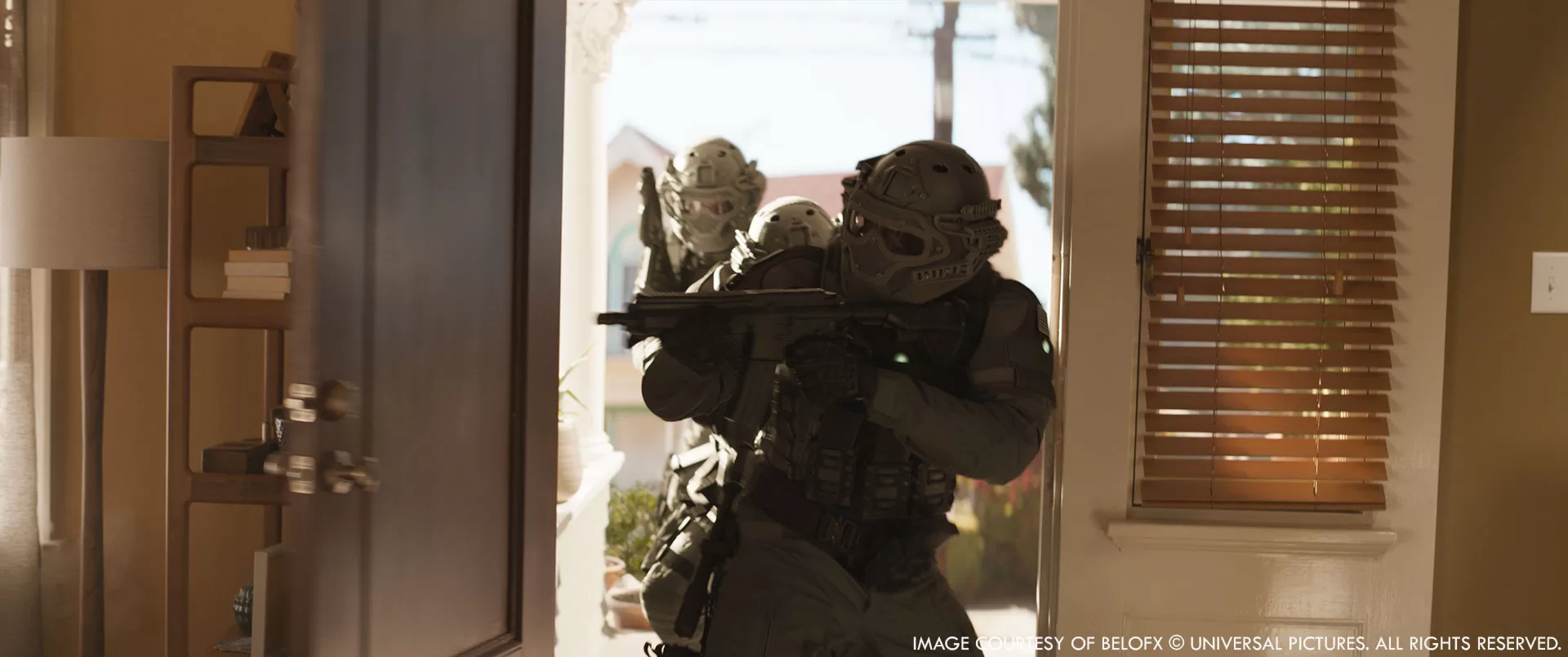
What is your best memory on this show?
Always the crew. In the words of Dom Toretto, it’s about family. I’ve been really lucky getting to work alongside such wonderful, creative, understanding and supportive people so yeah, they’re the best thing for me.
How long have you worked on this show?
I started having first conversations on the show in July 2022 and we wrapped up around April 2023, so about 9 months in total.
What’s the VFX shots count?
We delivered 410 shots.
What was the size of your team?
Across all our sites we had a crew of approximately 100.
What is your next project?
I’m currently working on an unannounced project for AppleTV+. Sorry, that’s a bit of an unhelpful answer but it’s all I can give you for now!
A big thanks for your time.
WANT TO KNOW MORE?
beloFX: Dedicated page about Fast X on beloFX website.
© Vincent Frei – The Art of VFX – 2023


